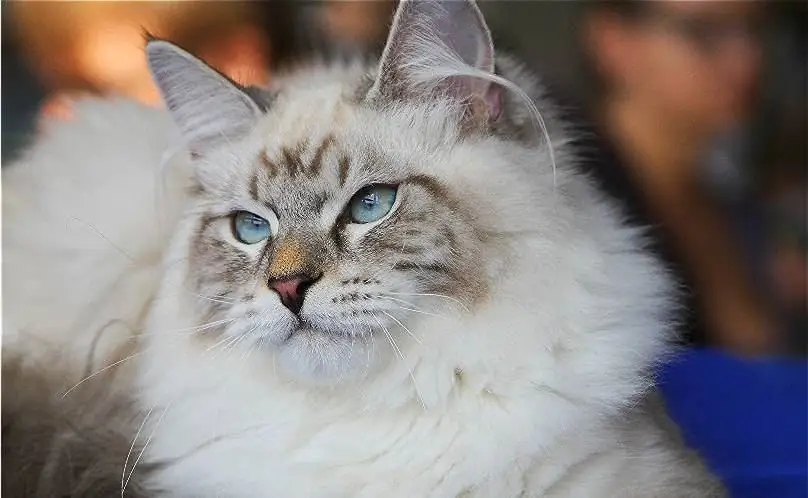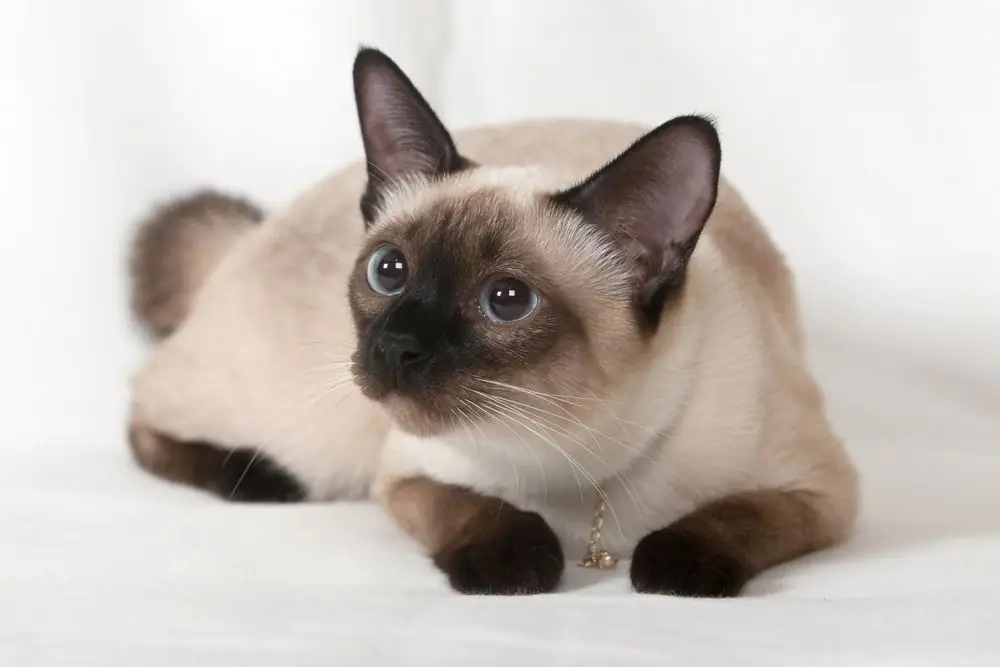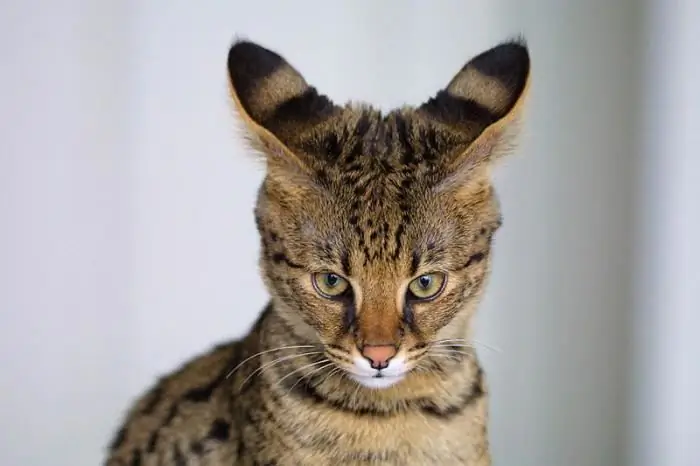2026 Author: Priscilla Miln | [email protected]. Last modified: 2025-01-22 17:55:26
In the hot climate of Africa live amazingly beautiful cats - servals. Local residents have long learned to tame these wild animals and often keep them either in their homes or in specially equipped enclosures. However, you must agree that living next to such cats is not the best idea. In addition, in most countries, the keeping of predatory animals at home is strictly prohibited. Therefore, an alternative solution was found: in the mid-80s of the last century, the first Savannah kitten was born. His parents were a wild serval and an ordinary domestic cat.
New breed
The first generation of Savannah cats is designated by the index F1. The animals belonging to it are considered the most expensive, as they are half servals. All subsequent generations are formed by crossing Savannah cats with cats of similar breeds. For example, they include Bengal, Egyptian Mau and the like. SoThus, the higher the generation index, the more the animals resemble ordinary domestic cats, and not servals. Because of this, their value is greatly reduced.
As mentioned above, a first-generation Savannah cat is very expensive. And this is not surprising, since such animals are almost the rarest in the world. Although savannahs were highly valued from the very beginning of their appearance, their official registration took place only in 2001. As for the breeding of this relatively young breed, this is a rather difficult matter, so it has not yet become too widespread.

Savannah cats: breed description
These beautiful animals have inherited from their wild relatives a lot of their inherent features: an elongated body, strong legs, a long neck, a short and fluffy tail with a black tip. But perhaps the most characteristic features of this breed are extremely large and erect ears, unusually beautiful eyes, as well as a very attractive "leopard" color.
The Savannah cat, whose photo is posted in the article, has a short, thick and very soft coat. The size and location of dark spots on it is arbitrary. However, they can vary from brown tones to deep black. The color can be the most diverse: silver, chocolate, golden, brown and even tabby cinnamon (light brown with dark stripes). What will be the coat of a kitten directly depends on the appearance of a domestic cat mated withthoroughbred savannah.
The size of each animal is determined by its class. The heaviest and largest Savannah cats can only belong to the first or second generations (F1 and F2), while their height reaches 50-60 cm, and their weight is 14-15 kg. Females are slightly lighter and smaller in size. All other generations of animals differ even more from the above norms. I must say that savannahs reach their maximum size by the age of three, and this parameter, along with weight, depends precisely on the breed of the male.

Savannah cats: a description of the general breed standards
- Large size animals with somewhat elongated slender body.
- A small wedge-shaped head set on a long neck.
- Ears wide at the base, large and pointed at the tips.
- Long, strong and slender limbs.
- Almond-shaped eyes of copper, yellow or green, or any of their shades.
- Short, soft and rather dense coat of the so-called "leopard" color.
- Spots of black or brown colors, the rest of the coat is chocolate, silver, brown, golden or tabby cinnamon color (photo of a savannah cat).
Adults and their nature
The behavior of these animals is completely unlike the wild disposition of their relatives - servals. Savannahs quickly become attached to a person, seeing him as their companion, and in this they are very similar to dogs. In addition, they can demonstrate the same loy alty to their master as dogs. However,despite being attached to a person, they easily endure loneliness. Savannah cats are very inquisitive and courageous animals. They prefer active games, but if the owner has no time to mess with them, then they will occupy themselves - for example, they will fool around a bit, putting their order around the house.
Their favorite pastime is games that imitate hunting. For cats, the main thing is the process of chasing prey, so that they can run and jump to their heart's content. Most likely, they inherited such preferences from their wild ancestors - servals. Sometimes, some Savannah cats can be quite aggressive, but this is very rare. It happens that during the game, animals can somehow injure or scratch a person, so they are not recommended to be left alone with small children.

Animal care
Despite the fact that the Savannah cat breed is exotic, it does not require any special care. Since these animals are short-haired, all attention to their coat comes down to combing and bathing. The first of the procedures is done once a week, and the second - no more than 4 times a year. Savannah cats are very fond of outdoor walks and it is best to use a leash for this.
For purebred animals, experts always recommend using an exceptionally balanced diet, which is easily provided with the help of special premium feeds. They differ somewhat from each other depending on the age of the cat. At the same time, breeders stronglyrecommend avoiding grain-rich foods. In addition, from time to time it is advisable to add special cat treats to food, which include taurine, as well as products that help remove hair from the stomach.
As for natural products, small pieces of raw meat should be added to the feed, as it is believed that this particular product prolongs the life of savannahs by about 5-10 years. Do not give them fermented milk products that are recommended for cats of other breeds, because this can lead to indigestion. The feeding regimen and portion size must be checked either with the breeder or read the instructions on the food packaging. Most often, kittens are fed at least 3-6 times a day, and adults - no more than 3 times a day.

Content Features
Before such a Savannah cat appears in the house (the photo shows its external features), it is necessary to gather all family members and discuss the rules for handling the animal in order to develop a single principle for its upbringing. If there are many rooms in the house, then you should first keep the kitten in one or two, and eventually introduce him to the rest of the rooms. In this case, it would be advisable to place several trays at once in different parts of the house.
If Savannah cats are kept in an apartment above the second floor, then all mosquito nets should be strengthened as much as possible. The fact is that both the base and their mounts are made of plastic, so if animals show excessive interest in flying forwindow to birds, insects, etc., they may fall out and, gliding on it, receive various kinds of injuries.
Don't forget about poisonous indoor plants. They will need to be removed as far as possible from an overly curious kitten. In addition, the wires of electrical appliances will have to be fixed or hidden for at least seven months, since at this time savannahs can use them as teethers. Do not underestimate the usual security measures: be sure to close containers with water, packs of washing powder and other household chemicals, and put away valuable and breakable items.

Optional equipment
Savannah cats are very fond of jumping and climbing, so you need to take care of at least special multi-level shelves on the walls. In private houses, a safe and spacious aviary can be equipped for them. You can put not only shelves in it, but also a whole tree. It is worth noting that the constant keeping of an animal in an aviary is simply unacceptable. Such cats need daily one- or two-hour walks. It must be remembered that their free range is highly undesirable.
Usually, a scratching post is also placed near the feeding place. It is not so important what configuration it will be, but most often it is a high pole with a small platform at the top. It would be useful to ask what kind of scratching post the kitten is already used to. As a rule, the Savannah cat (photo) is very smart, so it is quite easy to retrain him: you just need to use a spray containing valerian or catmint.
Animal breeding
As mentioned above, the Savannah cat, whose mating is associated with certain features, was obtained by mating a serval and an ordinary pet. As you know, representatives of this breed, belonging to the early generations, there is a certain level of so-called hybrid non-viability. It manifests itself in the sterility of male serval hybrids up to the fifth generation. They are given to new owners already castrated.
Most often, Savannah cats are mated with F5 males, that is, the fifth generation. In addition, females of this breed are allowed to mate with ordinary short-haired mongrel cats, as well as Egyptian Mau, Ocicat, Bengal and Oriental Shorthair, which have a spotted color.

Development Features
It is known that the gestation period for ordinary domestic cats is about 65 days, and for a serval - up to 77. As a result of this difference, hybrids of earlier generations are often born prematurely, so they are in dire need of additional nursing. The litter of hybrids of the first two generations usually consists of 1-2, and the next - of 3-5 kittens. Savannah cats are able to get pregnant as early as 4 weeks after giving birth, however, breeders themselves limit the number of matings to two or three per year.
These animals feed their kittens with milk up to 8-12 weeks. At first, babies will almost always sleep. In this state, their body is directed to the maximum production of growth hormone. That is why it is not recommendedwake up or disturb the kittens in any way during this period. When they reach the age of 10-12 weeks, they are spayed or castrated in order to soon be transferred to new owners.

Medical problems
When deciding to get such a cat, one must take into account that walking in an aviary or on a leash requires additional financial and time costs: accustoming to the street, keeping the aviary, preventive examination by a veterinarian, deworming, additional vaccinations, etc. A trip to the veterinary clinic with the first two generations of Savannah is often a problematic event for both the animal itself and its owner.
No special he alth problems have been identified in representatives of this breed, with the exception of those that are inherent in other domestic cats. Usually, all difficulties that arise are solved by regular veterinary examinations, timely vaccination, high-quality balanced nutrition and good care.
Owner Reviews
Happy owners of savannas are sure that this is almost the most intelligent and inquisitive cat of all breeds that exist today. They easily open not only the doors of the rooms, but also cabinets, while pulling out all the drawers. They are not afraid of water at all and take baths with pleasure. These animals are very good at jumping over 2.5 meters.
Savannah cat (photo), especially belonging to the first generations of hybrids, can sometimes show its wild temper, which is expressed in growling and hissing in the presence of strangersof people. In addition, he can make special chirping sounds inherent in servals. Such a pet will not sit on the hands of even the owner and does not like being stroked on the head. But the fourth-generation Savannah practically does not differ in its behavior from other domestic cats.
Recommended:
Neva cat breed: photo and description, characteristics of the breed, reviews

Domestic cat lovers want certain qualities and mannerisms in their pets according to their preferences. Some owners are attracted to furry creatures by nobility and wit. Others like to play with animals, so they appreciate their playfulness and nimble character. There are also owners for whom the exterior of the purr, its attractiveness, is an important criterion when choosing. So, the Neva cat breed has collected many characteristic features inherent in such affectionate animals
Siamese cats: photo, description of the breed and character, owner reviews

Siamese cat is elegance, grace and sophistication. Perhaps, among all representatives of domestic cats, she is the most aristocratic and characteristic. The oldest breed is famous for its selective attitude towards people around. It is not easy to win their trust. Siamese cats are loved, feared, feared, but one way or another, they are always admired
Dogs of the Drathaar breed: description of the breed and reviews

The article describes the features of the German Drathaar breed. The hunting dog has all the necessary skills in order to chase and get game
Breed of big cats. Names and photos of breeds of big cats

Today we will talk about big domestic cats. If you are not familiar with such amazing creatures, then this article is for you
Burmese cats: description, character, care features, photos and owner reviews

Small cute Burmese cats are very popular in the USA. They are well known in Europe, although their numbers are slightly lower there. In our country, this is a rather rare breed. It is little known to Russians, since its active development began only in the mid-1990s

